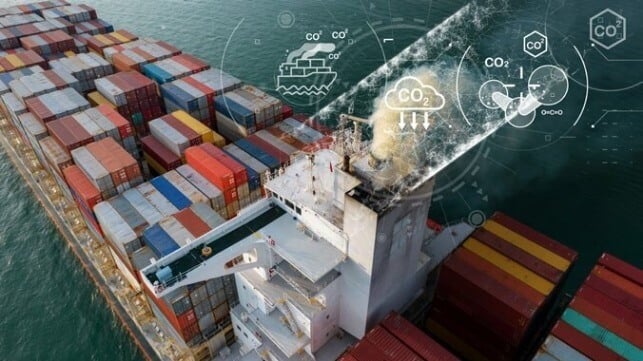The maritime sector is in a sprint to slash emissions, employing everything from innovative technology to the age-old concept of sails. It’s fascinating how we’ve come back to using wind power,once the domain of pirates,as a beacon for lasting shipping.What an exciting era!
While we dream about futuristic solutions like warp drives and fusion energy, the industry is currently exploring alternative fuels such as methanol, ammonia, and hydrogen. hybrid systems and electrification are also on the table as regulations tighten their grip: The IMO’s 2023 energy efficiency rules are now in play; by 2024, the EU Emissions Trading System (ETS) will include maritime operations—tripling compliance costs by 2030—and FuelEU Maritime has set stringent emissions targets starting this year.
The IMO’s strategy aims for net-zero emissions by 2050 with interim goals: a 20% reduction by 2030 and a whopping 70% cut by 2040. Mid-term measures are expected to be outlined by 2027 after crucial meetings this year.
It’s an exhilarating race fueled not just by wind but also data—and perhaps a hint of regulatory urgency.
“GO GREEN AND SAVE SOME CASH”
The Liberian Registry (LISCR), which holds the title of largest ship registry globally based on gross tonnage, plays a pivotal role in helping the maritime industry meet its decarbonization goals.Thomas Klenum, Executive VP of Innovation & Regulatory Affairs at LISCR, shares insights into how they’re tackling these challenges head-on.
“We aim to fast-track our journey toward net-zero emissions by mid-century while embracing innovation,” he explains. In line with this vision is LISCR’s newly formed Innovation and Energy Transition Team launched in early 2024 that collaborates closely with shipowners and design firms right from conception stages.
A notable aspect of LISCR’s approach involves incentive programs aimed at promoting greener practices.
“We provide discounts on registration fees for vessels participating in eco-friendly initiatives,” Klenum notes.
This initiative aligns well with evolving regulations like EEXI and CII requirements—sending out a clear message: “Go green to save some cash.”
While alternative fuels often steal the spotlight, Klenum emphasizes that improving efficiency is equally vital. “Wind-assisted propulsion systems have shown great promise,” he mentions while hinting at upcoming data releases from vessels flying Liberia’s flag that utilize these technologies.
Hull optimization remains another focus area. “With zero-emission fuels likely being costly or scarce initially,” he adds emphatically, “efficiency becomes essential.” Streamlining hull designs can lead to substantial reductions in fuel use and operational expenses.
LISCR isn’t shying away from onboard carbon capture either; they’re pushing boundaries here too. “We’ve proposed recognizing carbon capture as an official decarbonization method within IMO discussions,” Klenum reveals while stressing that regulatory frameworks need updating so shipowners can gain credit for captured emissions effectively.
The revised GHG Strategy introduced complexity through its shift from tank-to-wake assessments towards well-to-wake evaluations—a move that could allow ships using certain fuels even to achieve negative CO2 impacts depending on production methods,” he explains enthusiastically about potential new pathways toward net-zero outcomes.
LISCR is also diving into cutting-edge tech trials involving AI-driven autonomous shipping alongside Avikus—aiming for gains not only in route planning but also machinery management and collision avoidance—all contributing positively towards both emission reductions and safety at sea!
Klenum candidly discusses nuclear power too: “Our experience lies more within fixed-location nuclear plants due to simpler local regulations; however trading nuclear-powered ships globally presents intricate challenges.” He acknowledges ongoing talks aimed at modernizing outdated codes governing nuclear vessels under IMO guidelines
.
Despite obstacles ahead though? He sees promise! “In time,” he suggests optimistically “nuclear could emerge as key player offering stable low-emission solutions compared against handling hazardous alternatives over decades.”
Klenum expresses concerns regarding fragmented regional emission laws stating firmly: “Global standards should originate from IMO ensuring fairness across international waters.”
Cautiously optimistic about timelines surrounding mid-term measures? He believes it’s achievable—but requires global teamwork along with technological advancements plus scaling up near-zero carbon fuel availability! The roadmap includes MEPC meeting scheduled next April where critical decisions await regarding fuel intensity standards alongside pricing mechanisms—“we’re racing against time!” admits Klenum noting implementation slated early-2027!
SUSTAINABLE FUEL FUTURES
Auramarine based out finland specializes extensively within multifuel supply systems covering methanol biofuels among others—but beyond technical specs lies practical hurdles even top-tier setups can’t disguise!
.


Comments are closed, but trackbacks and pingbacks are open.